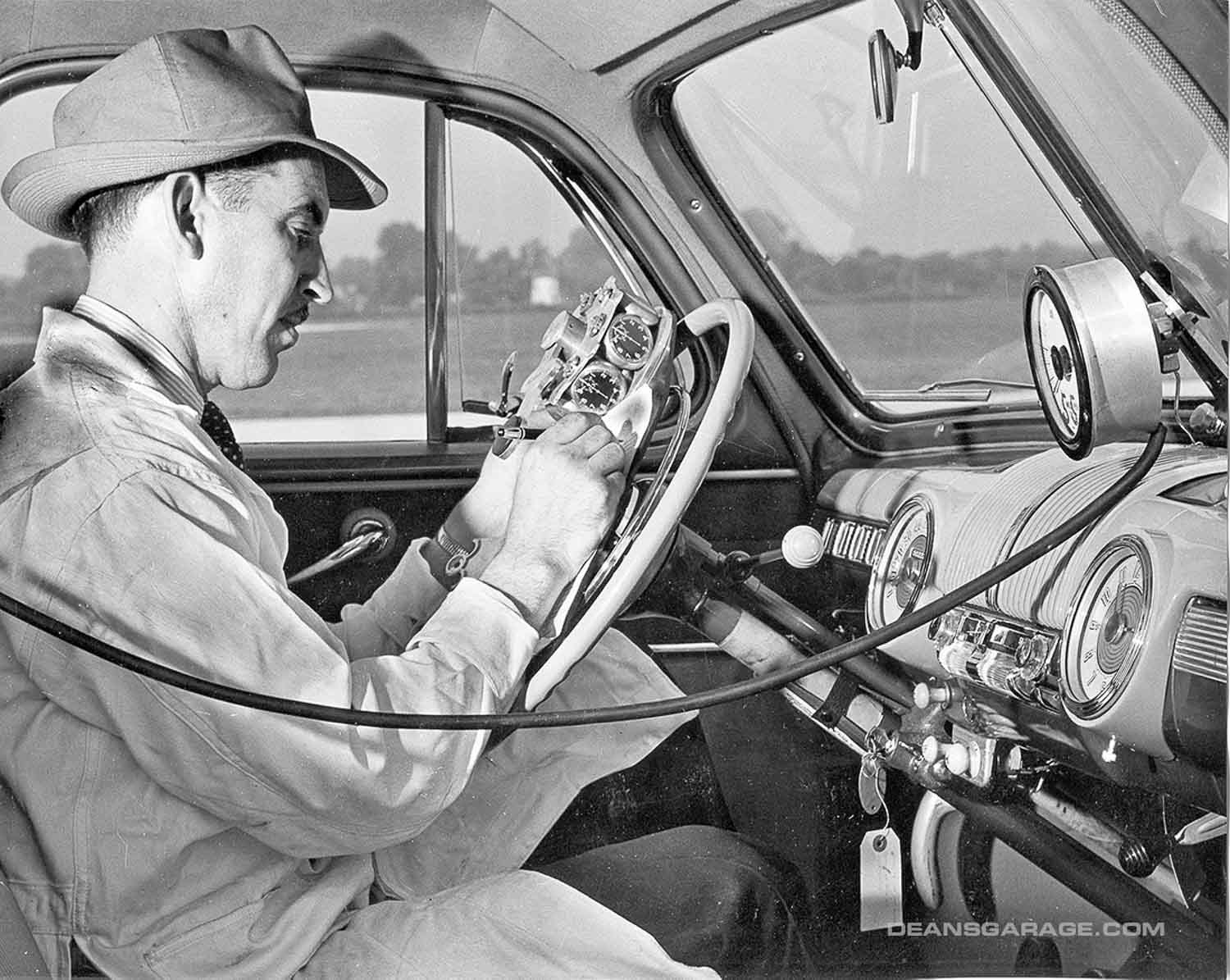
Dearborn Proving Ground
By Todd Duhnke
While Dean’s Garage naturally focuses much attention to the design and styling processes, there are two other key pre-production elements that are nearly as interesting, those being engineering and testing. In this story we’ll look at one of the key Ford testing facilities, the Dearborn Proving Ground. In an upcoming story we’ll look at the other two principal Ford test facilities, Michigan Proving Ground in Romeo, Michigan and the former Arizona Proving Ground near Kingman.
When it comes to rich Ford history few places have as much as the Dearborn Proving Ground, otherwise colloquially known as the Test Track and as of 2006, the Dearborn Development Center. While the history of this place is fascinating, it was also captured with many great photos in both the Ford and my personal archives.
Over the years Ford had numerous test tracks scattered throughout the United States, Canada, and the world. But these three in my mind stand out in particular as the most significant. This story will cover the Dearborn facility.
We all know Henry Ford was one of the 20th Centuries’ greatest thinkers, tinkerers, and developers of ways to improve the lives of all Americans. Not only was he one of the greatest proponents of the automobile, he was also an incredibly early proponent of civil aviation. And that started in November 1924 with two grass runways on the grounds of what is now the Dearborn Development Center. For, as you see, the test track of today began life on 365 acres as the first airport in southeast Michigan.
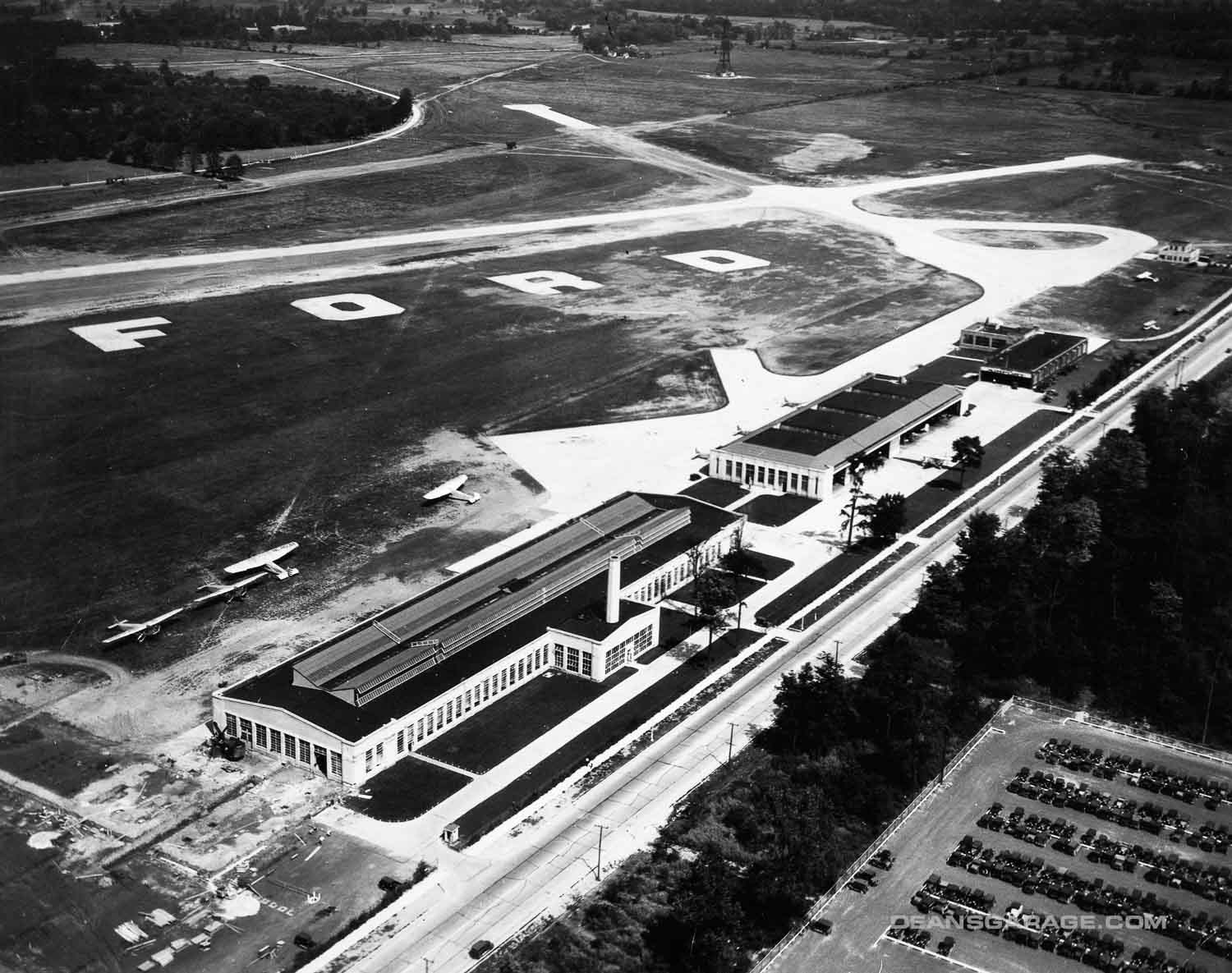
In 1925 airline service began by Ford Air Transport Service from this field to Chicago and back. In 1926, at the corner of Oakwood Blvd. and Village Road, hangars were built for the Stout Aircraft Company to begin production of all metal airplanes. Ford shortly thereafter bought Stout. This soon led to production of the famous Ford Tri-Motor airliner. With 199 built, it was truly the most successful airliner of its time, until the Douglas DC-2 and DC-3 arrived. Ford and the Ford Airport claimed numerous firsts beyond being the first airport in the U.S. with regularly scheduled, year-round passenger airline service. It was also the first airport with concrete runways, the first airport that had radio control between tower and commercial aircraft, and the first with contracted air mail contracts (CAM 6 and CAM 7). Regular airline service became routine, and a terminal building was built along Oakwood Blvd. Floodlights allowed for nighttime operations. Another amazing first was Henry’s idea that air travelers needed a place to stay close by. In July of 1931 The Dearborn Inn opened across Oakwood Blvd. from the terminal with Henry Ford signed in as its first guest. It was the world’s first airport hotel and remains in tip top shape today. A truly lovely place—I have stayed there numerous times. Marriott operates it today and has kept its rich history alive and intact.
Unlike most cities that have had one or sometimes two major civil airports since the dawn of commercial travel, Detroit has had four. By the mid 1930s airlines were also serving Detroit from the Detroit City Airport which is just northeast of and close to downtown. Airline service at Ford Airport slowly tapered away as a result, and Ford decided to make the airport one of the first dedicated automotive testing facilities in the world. That being said, GM had dedicated its first test track near Milford, Michigan a full 13 years earlier in 1924! On July 30, 1937, the Dearborn test track formally opened. By 1938 the first high speed tracks were built along the perimeter and just outside of the runway ends. The airlines were enjoying greater countrywide acceptance, and with increased traffic, finally fully abandoned Ford Airport to the larger Detroit City and Ypsilanti’s Willow Run Airports. However, Ford Air Transport Service remained until 1947, primarily serving the company’s needs.
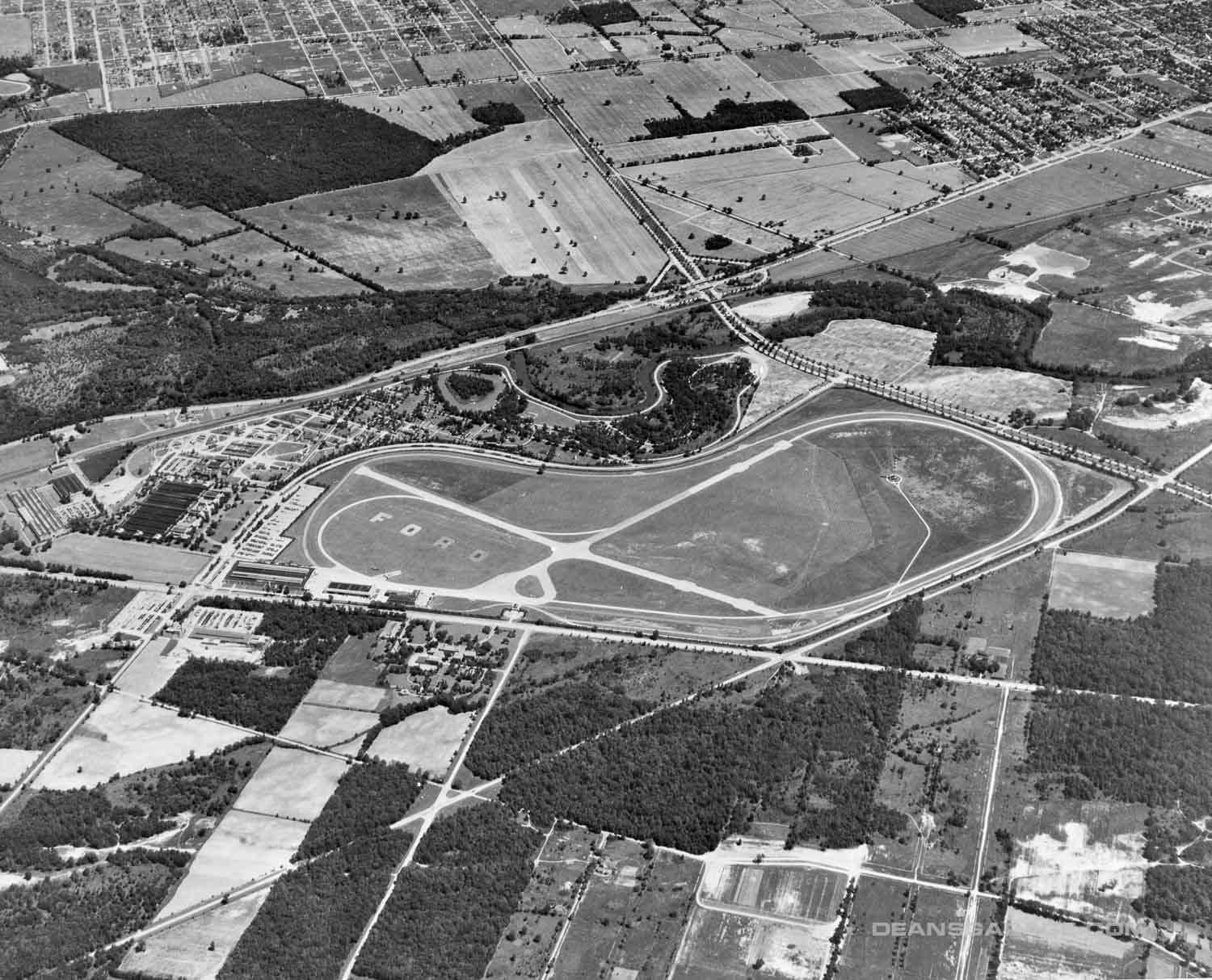
In this aerial photo we can easily make out the runways. Just below Oakwood Blvd. is The Dearborn Inn. Along Oakwood at the corner is where the Ford Tri-Motors were manufactured. Just left of that across Village Road is The Henry Ford Museum, and further left is the Engineering (EEE) Building. The top center, just below the Rouge River, is Greenfield Village which opened in 1928. Another interesting item to note is the mooring mast for dirigibles in the center right of the track. And what is truly amazing is just how rural the overall scene looks. Dearborn then was truly out in the country. So much undeveloped land on both sides of Michigan Avenue that crosses the photo from left to right. Today this area is 100% fully developed.
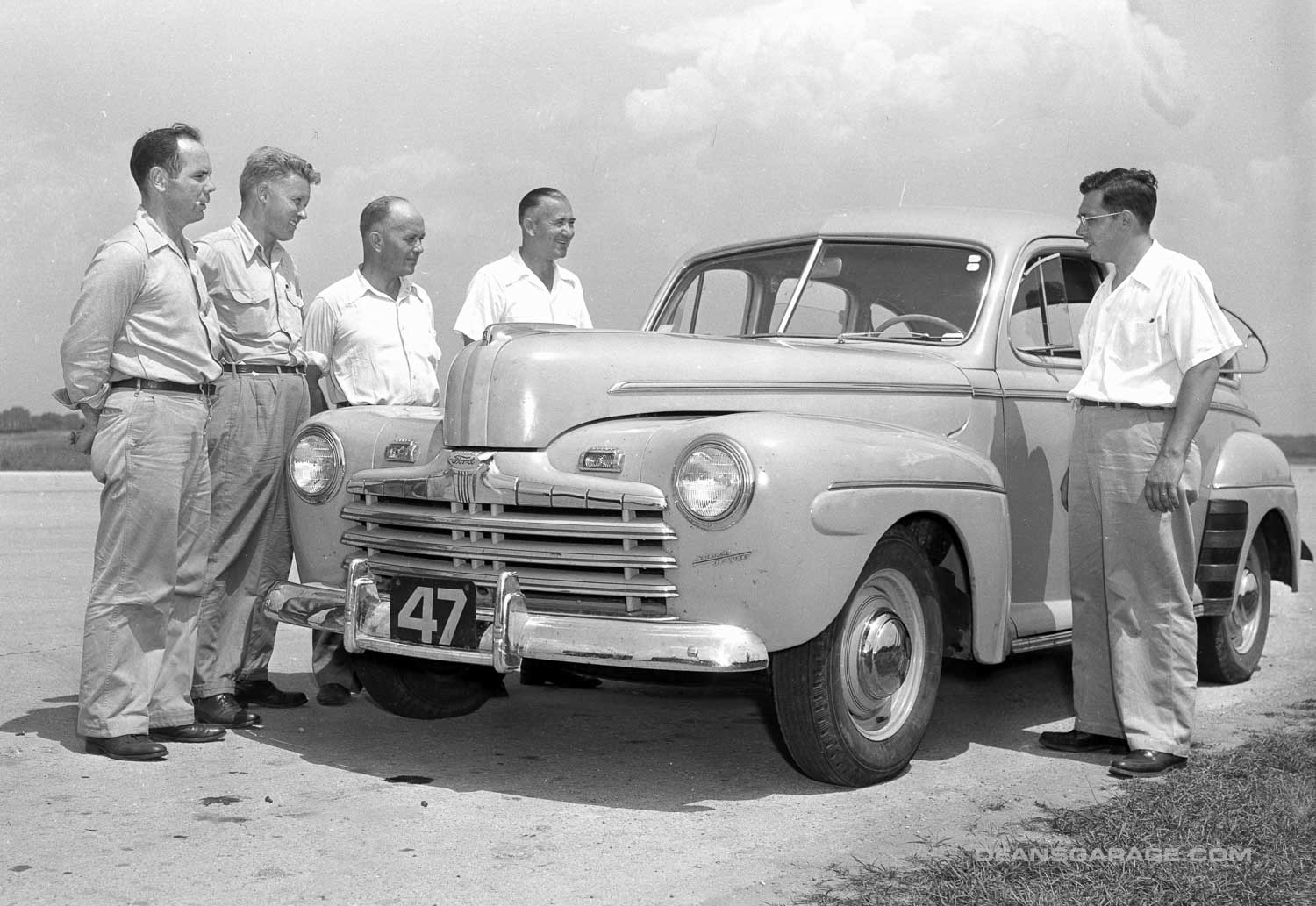
Interesting in that it is a ’46 Ford, but has “47” in the license plate holder. Based on other photos that was merely the number assigned to this particular test article

Early test equipment was naturally all mechanical and analog!
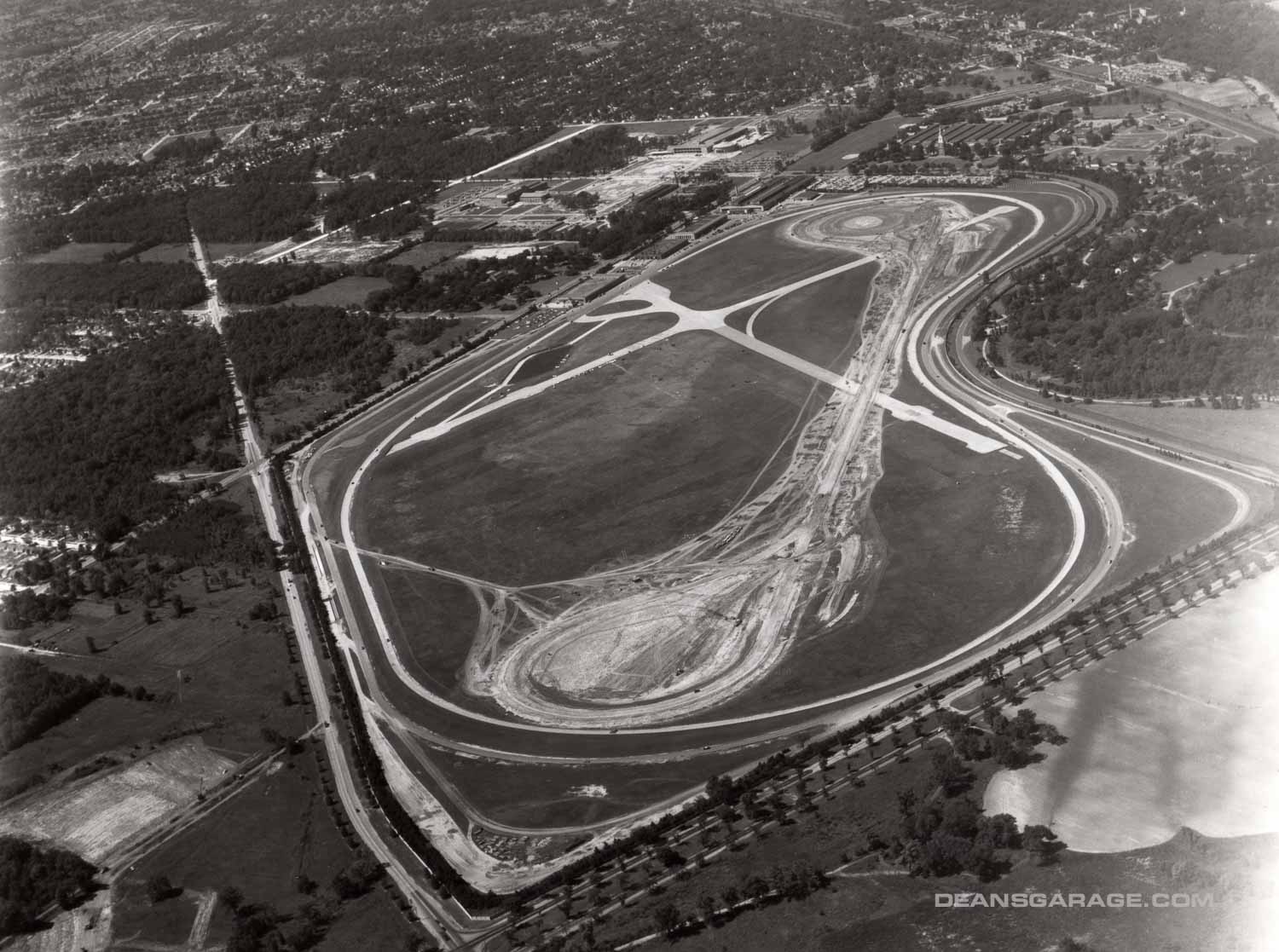
By September 1952 the development of the test track was coming along well. A long straightaway is in construction with their associated banked high-speed turnarounds. At 55 mph it was said you could take your hands off the wheel and the car would simply follow the turn!
By this time other testing buildings which once were airplane hangars are now used for indoor testing, Engine Labs, three cold testing rooms and a wind tunnel.
That’s Rotunda Drive on the left intersecting M-39, which will later be named the Southfield Freeway, joining on the bottom of the picture. At the top center of the picture you can make out the Product Development Center under construction, The Henry Ford Museum and Greenfield Village.
Lastly, a track outside of the high-speed track has been constructed with all kinds of different pavements a car might be exposed to in its lifetime. Belgian blocks, potholes, bricks, railroad tracks, cobblestones, and water up to 18-inches deep were all employed to test.
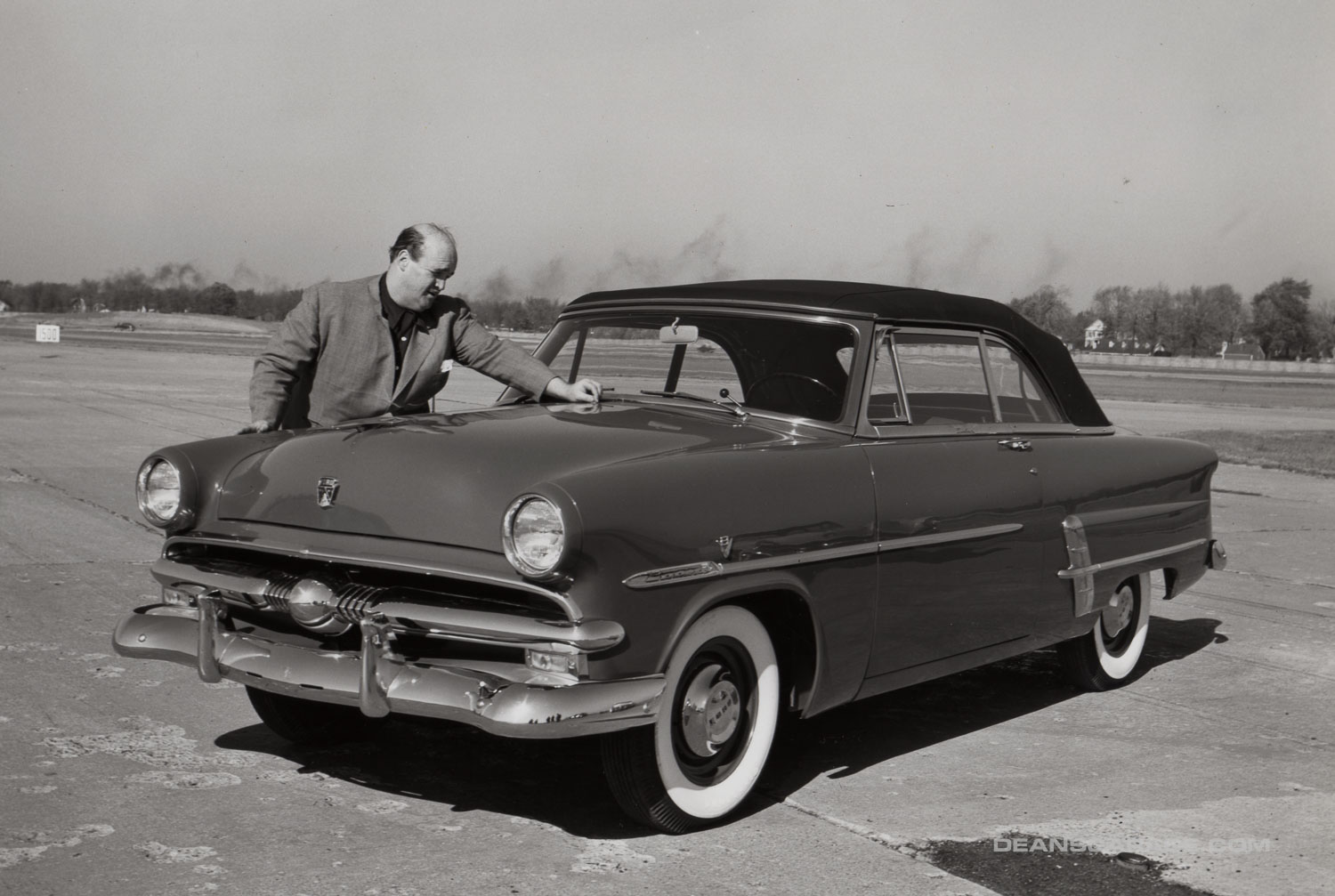
Not only was the test track used to evaluate the new cars, it was also used to test competitive vehicles and to allow the media with their associated long lead times to evaluate the new cars before unveiling them to the public. Here in the summer of ’52 “Uncle” Tom McCahill of Mechanix Illustrated fame tests a new ’53 Sunliner which he said, “was as smooth as an eel in a bucket of castor oil.”
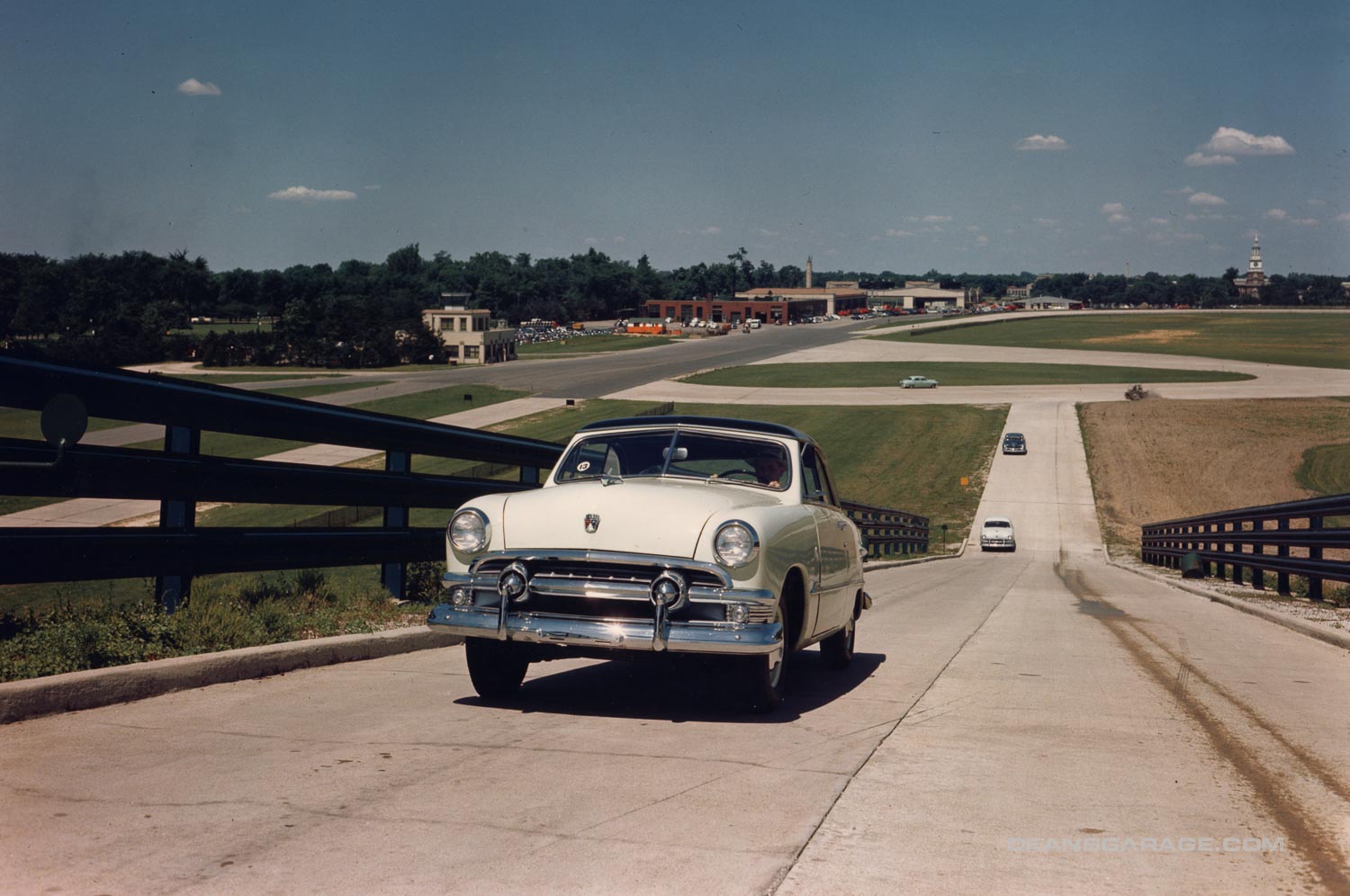
Ford also created a hill on the infield to test brakes, transmissions, parking brakes, and traction. Here a ’51 Victoria tackles a hill, the backside of which at a 30-degree grade is steeper than the steepest hill in San Francisco. Note the original airline terminal and control tower in the background above the right windshield post. Sadly, this historic building was torn down in 1961. Other test buildings are along the perimeter with the Ford Tri-Motor hangars in the distance.
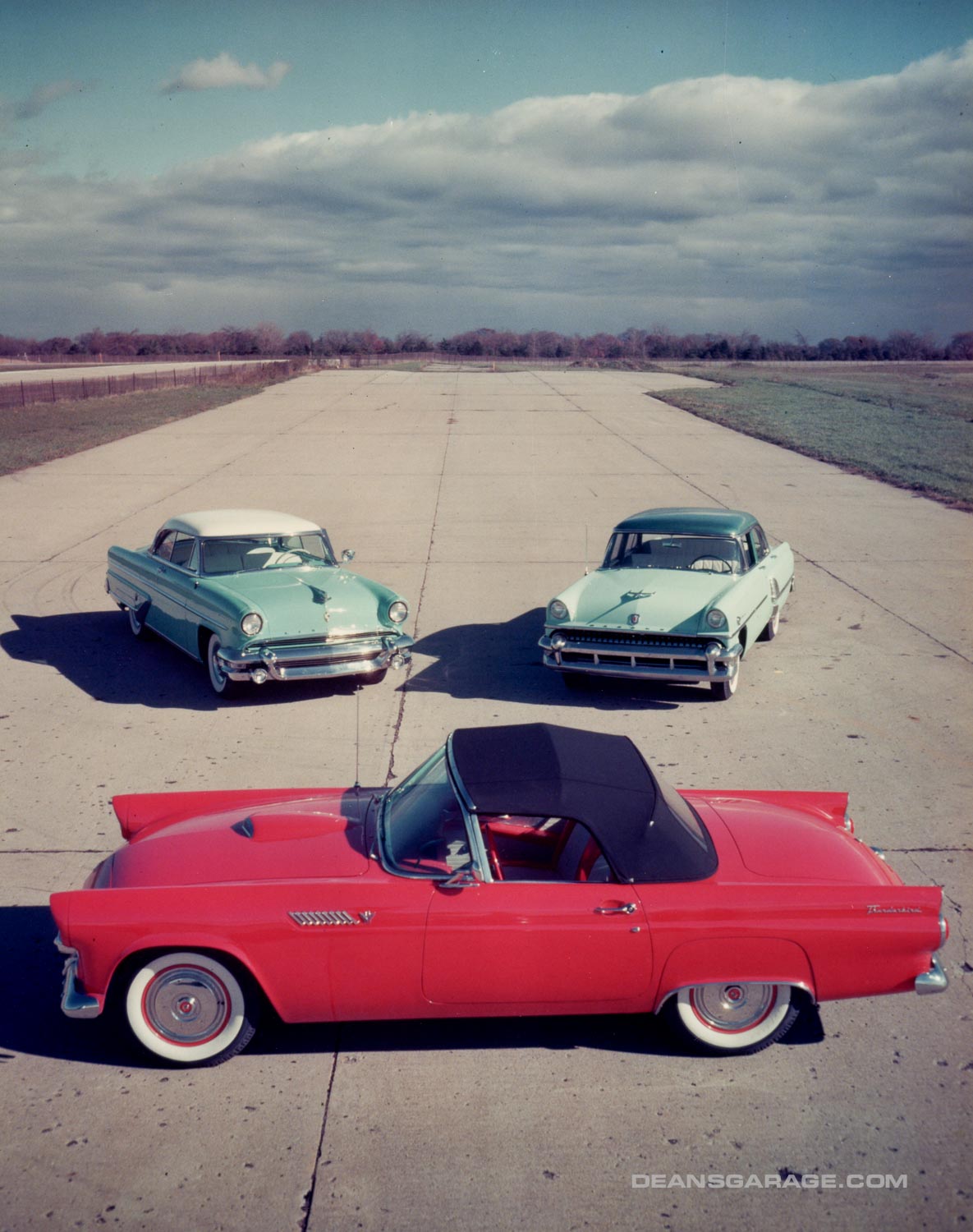
The test track also proved to be a great place to take publicity photos as it was completely out of view of the public. In 1951 a 7,100-foot long serpentine brick wall was erected mostly along Village Road to keep prying eyes off the new models. Here we have a newly minted ’55 Thunderbird along with a Mercury Montclair and Lincoln.
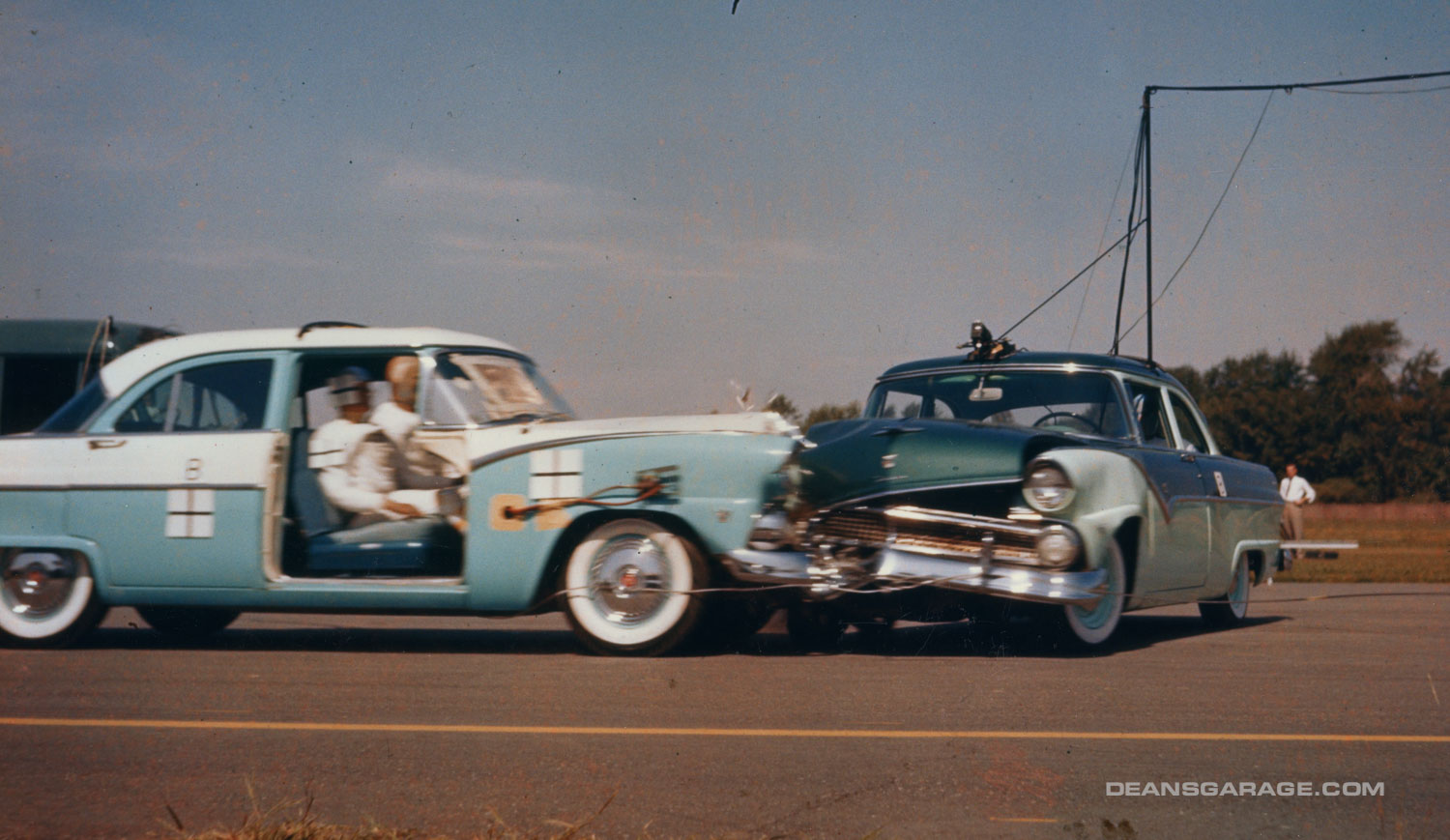
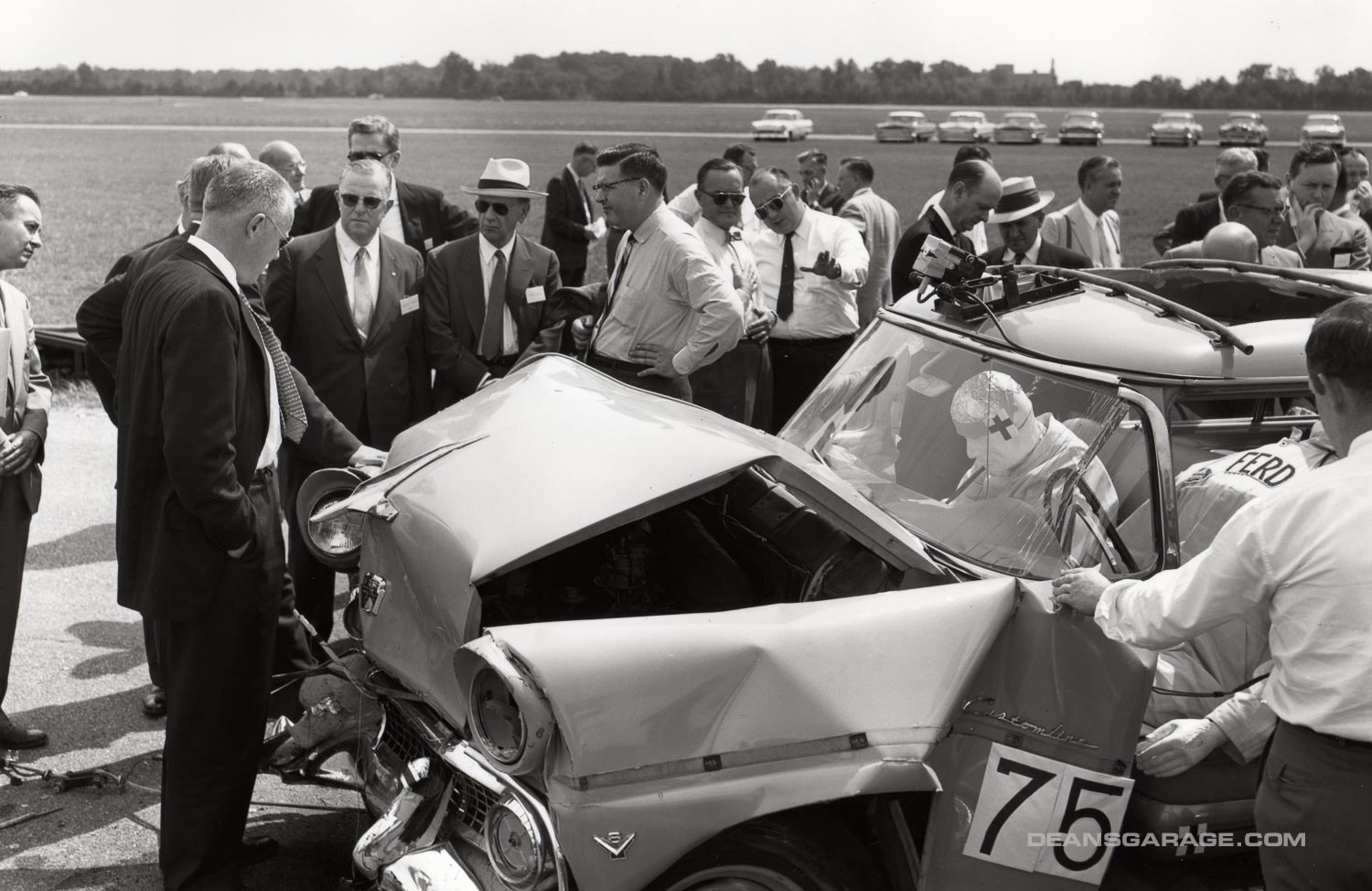
Ford was developing safety features well before the rest of the industry. This testing eventually led to the introduction on the ’56 Fords of seat belts first being offered along with padded instrument panels, padded sun visors, burst proof door latches and a deep-dish steering wheel design to absorb human impact.
Ford was also early in crash testing its vehicles in the interest of safety. Here, at the moment of impact, are two ’55 Fairlanes in a front to side collision. Next we have a ’55 Customline which was used to test door latches and seat belts. Note the high-speed camera attached to the roof to record the instrumented dummies.
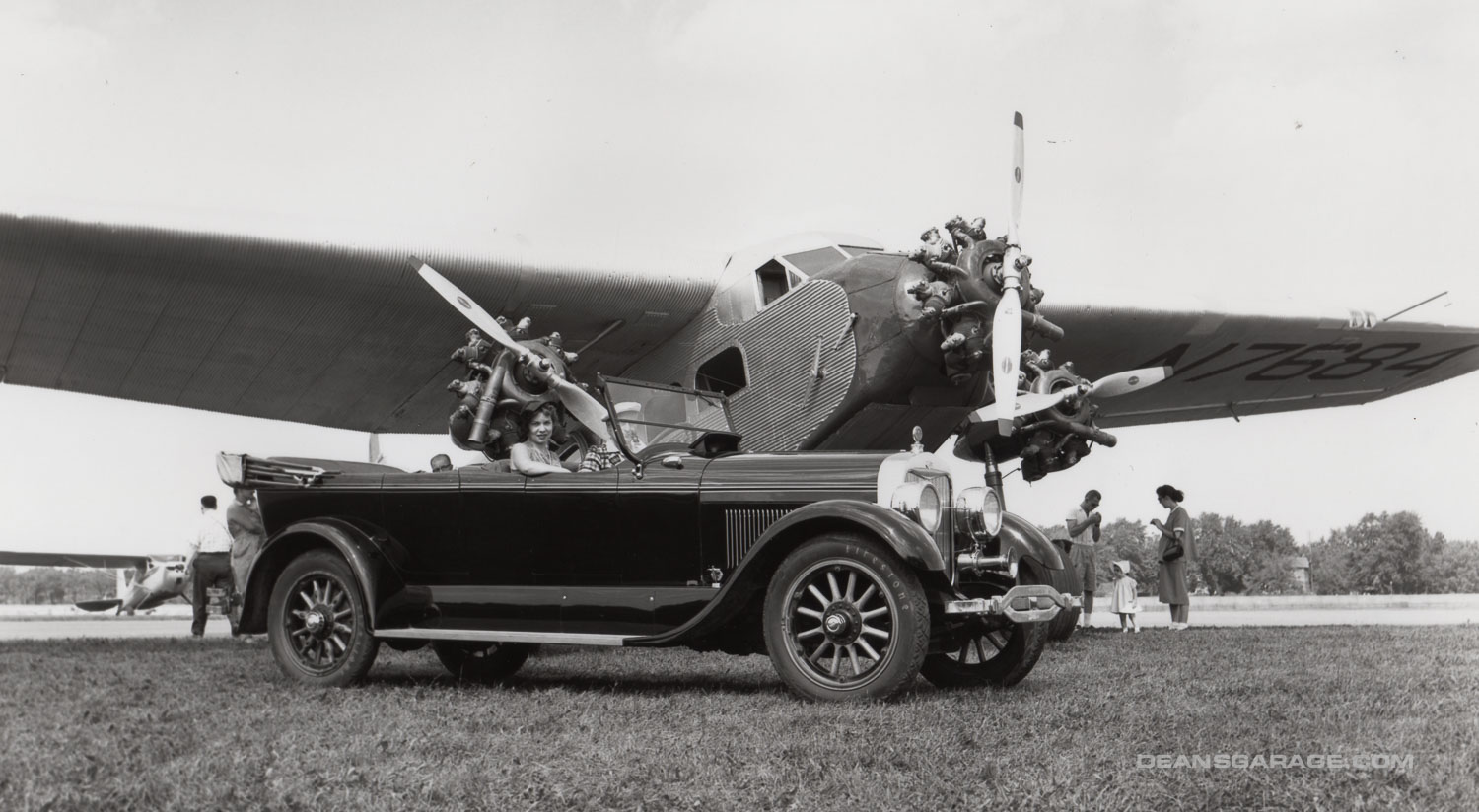
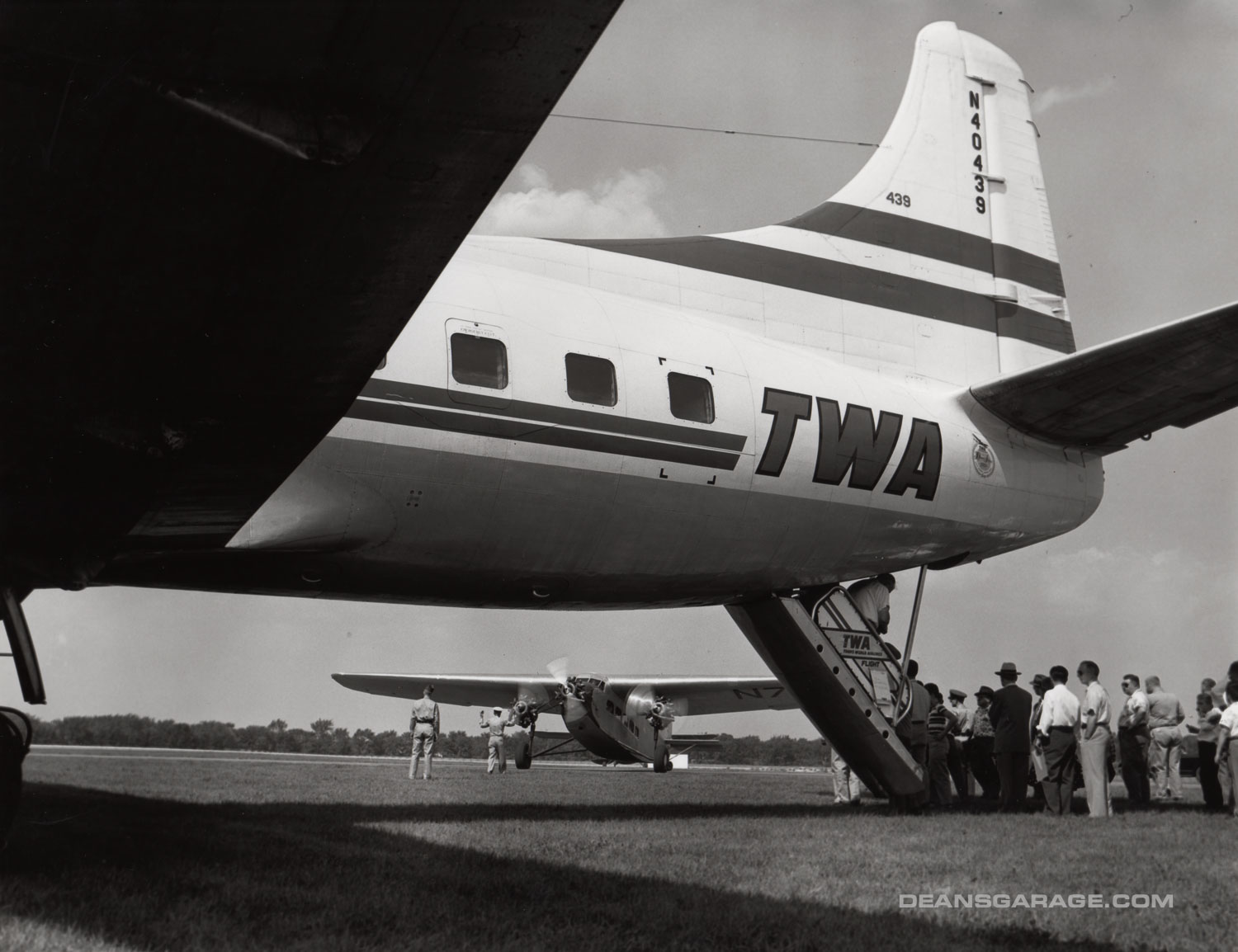
It wasn’t all work and no play as here we have two shots dated September 18, 1955 celebrating the 30th anniversary of the Ford Tri-Motor. Even TWA, who’s predecessor TAT was an early Tri-Motor user, came with a Martin 404 to celebrate the occasion. The Martin would have been a tight fit on the test tracks last remaining runway. Employees were given the opportunity to ride in a Tri-Motor and the 1925 Lincoln Phaeton. Thankfully this Tri-Motor, after suffering a major accident in 1972, was restored and is currently with a private owner in Lufkin, Texas.
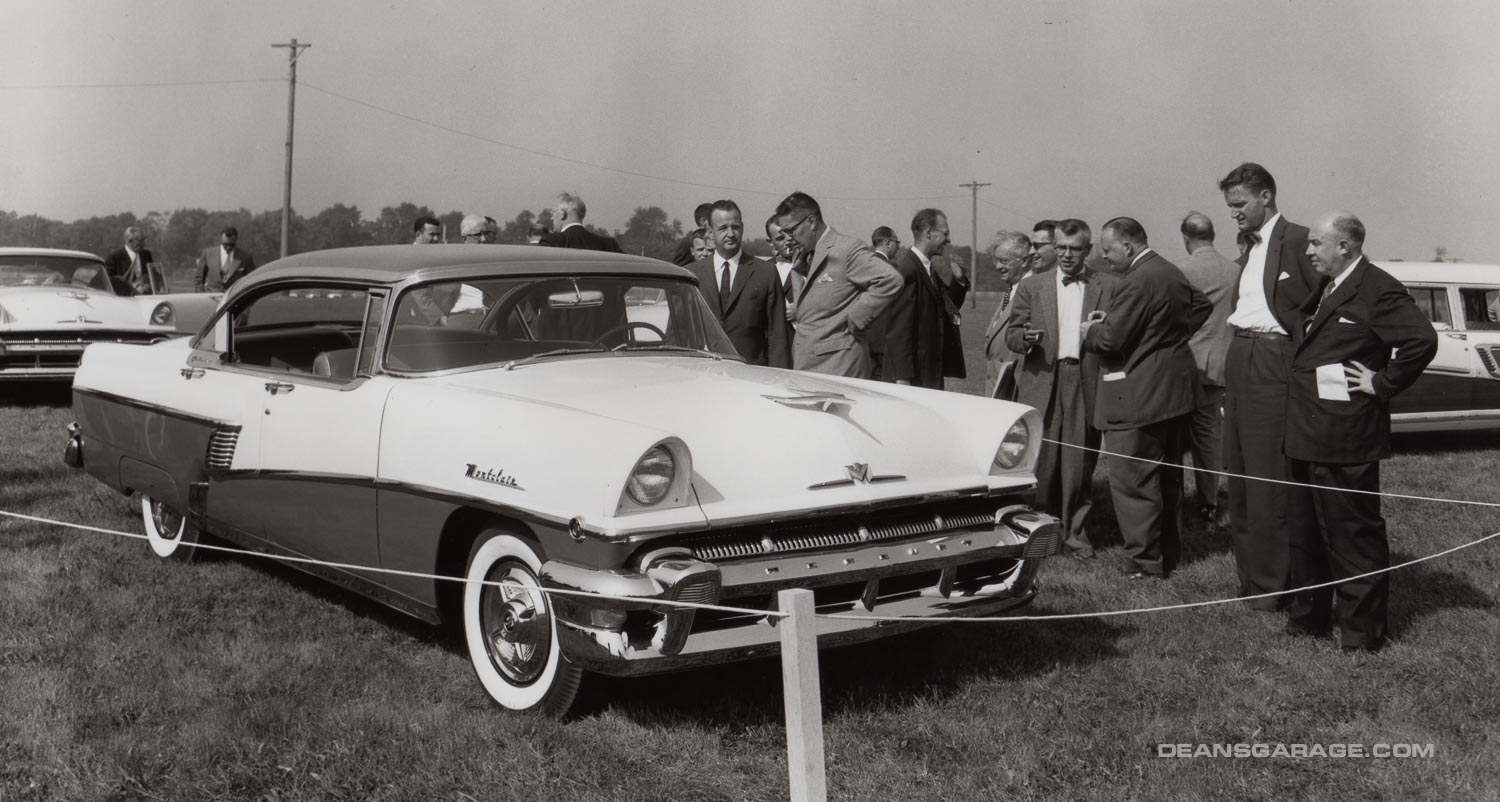
The test track was also used for discreetly introducing the dealers to the new, upcoming models. The new cars were usually unveiled to the public in late September and throughout October. Here Jack Reith, who in 1955 became General Manager of Mercury, and Benson Ford, then V.P. of Lincoln-Mercury Division review up close the new ’56 Mercury Montclair with some dealers on September 9, 1955.
Reith has his hands on his hips, Benson is on his right. Reith was one of the original “Whiz Kids” and largely got the blame for slow sales of the ’57-’59 Mercurys. He soon after left Ford for Crosley and sadly committed suicide a few years later.
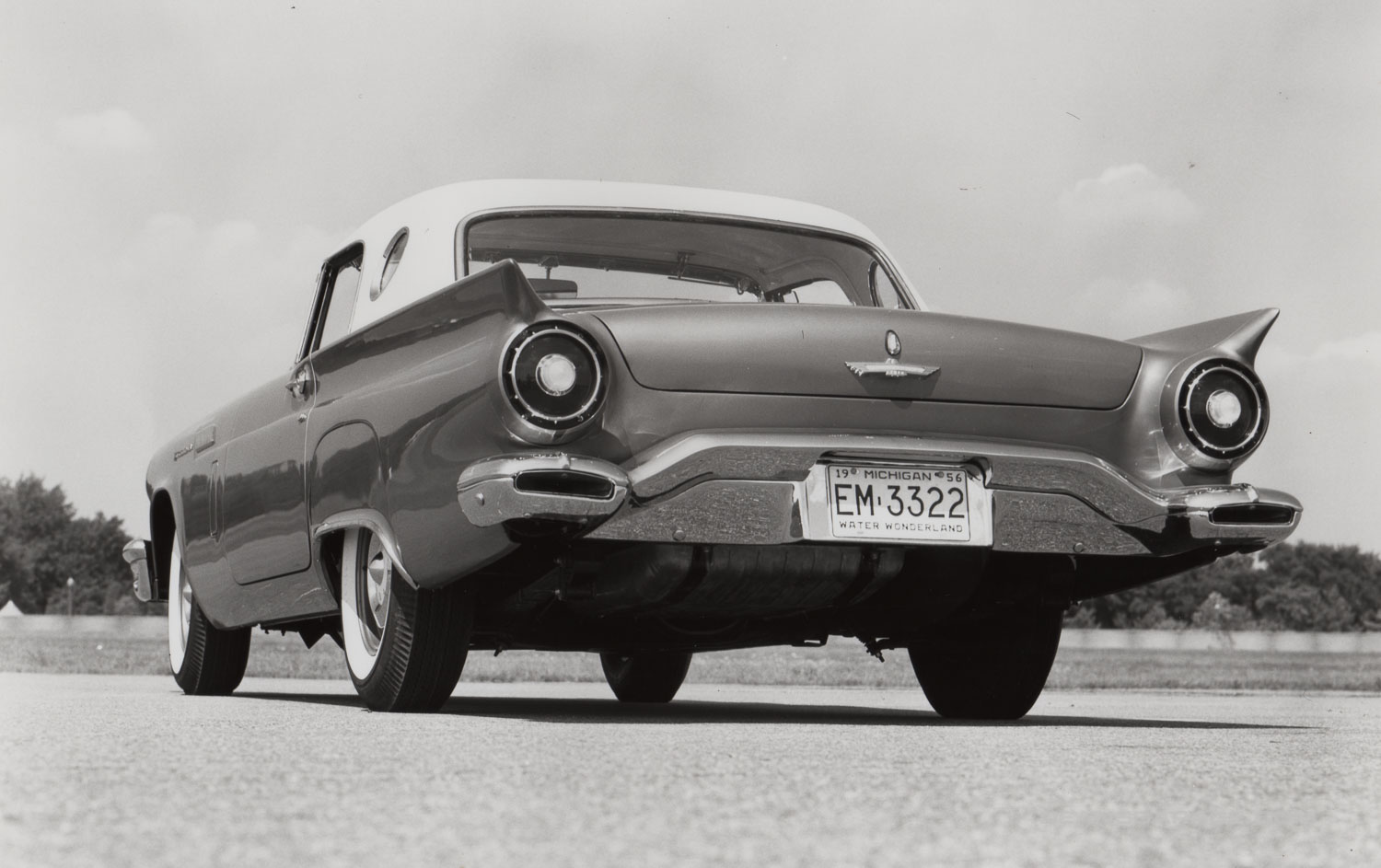
This brand new ’57 Thunderbird is pictured in the middle of the test track in August of 1956.
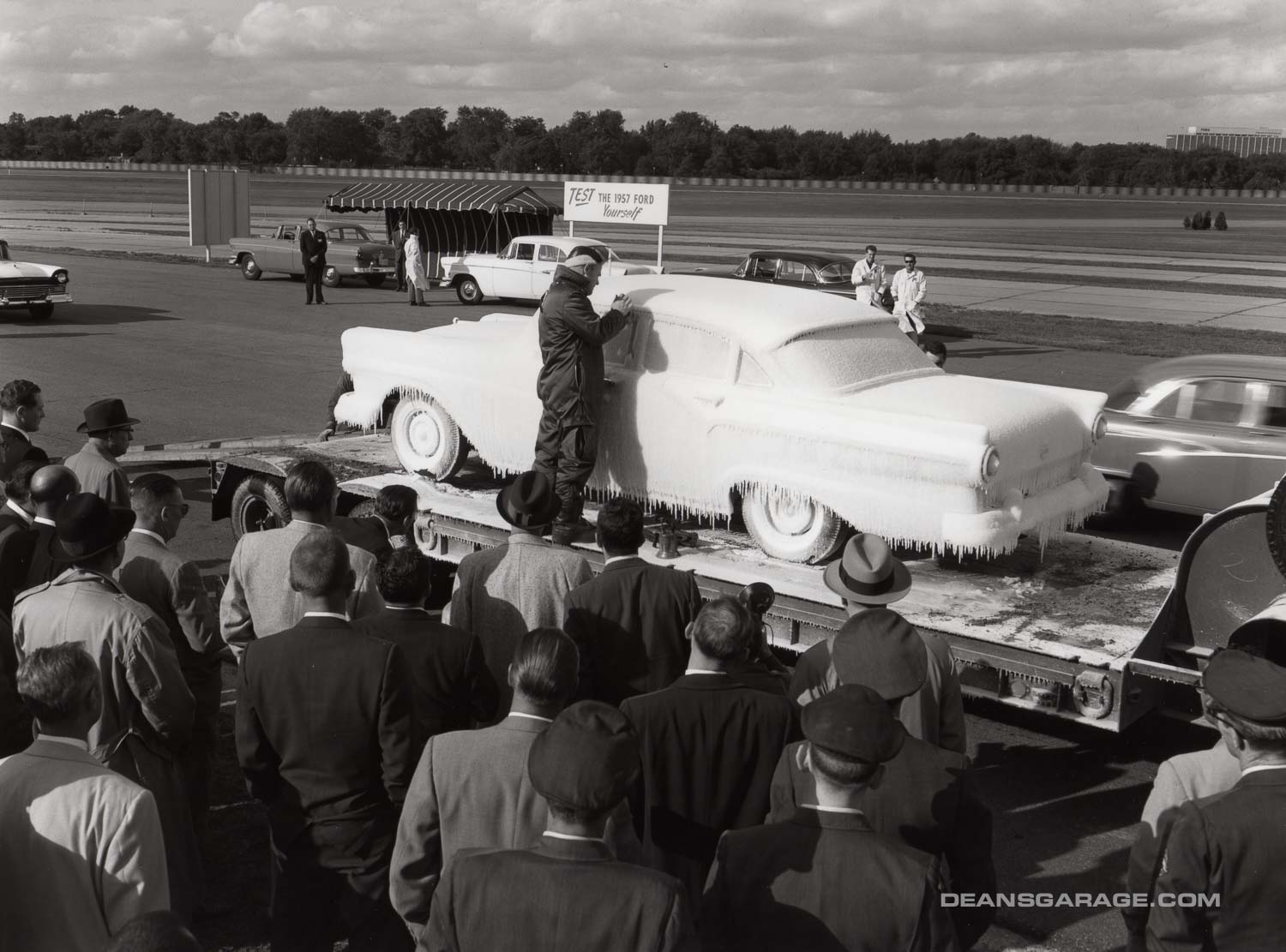
Meanwhile, on September 20, 1956, this very frozen ’57 Ford Custom 300 has just left one of the cold testing rooms for display to the automotive press. The sign in the background says, “TEST the 1957 Ford Yourself!”
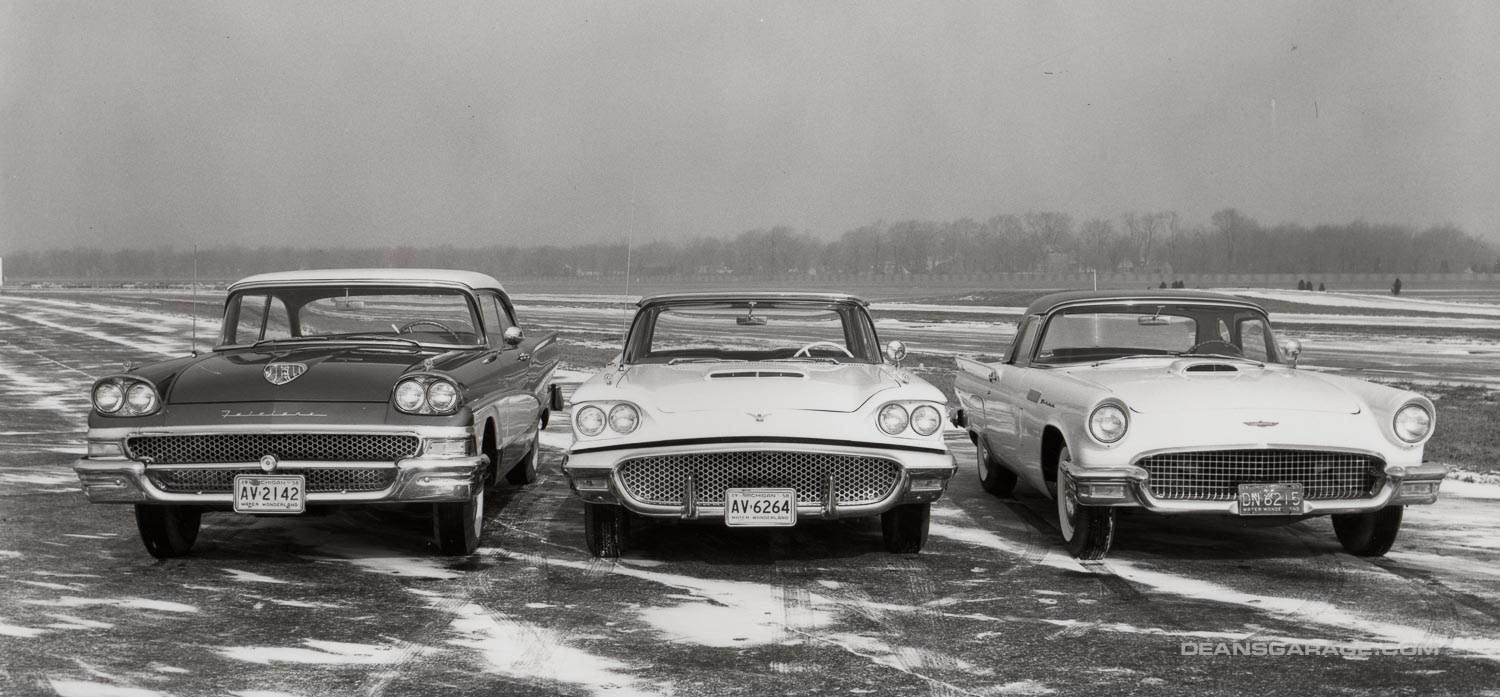
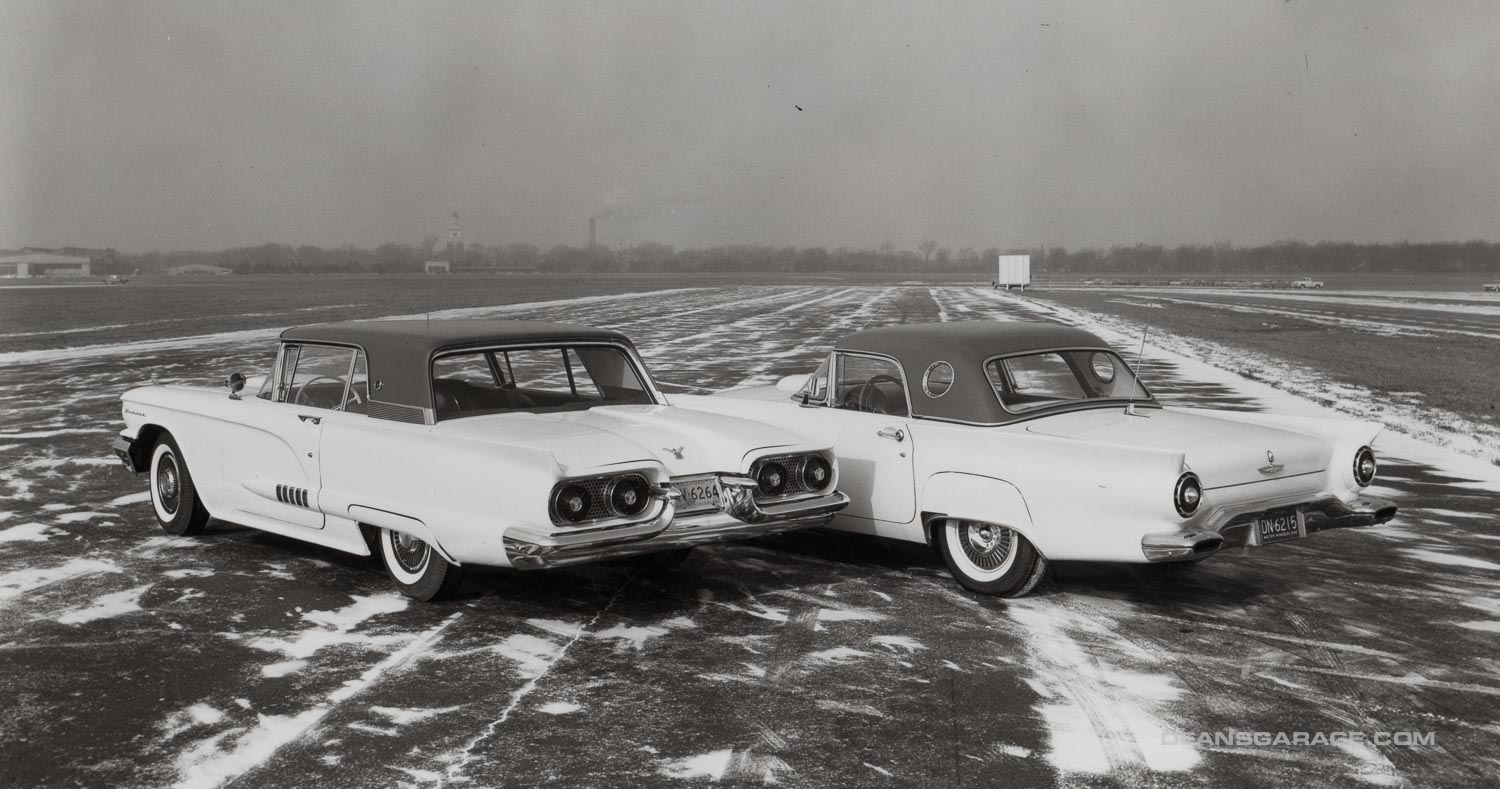
Photographed on a section of the remaining runway on February 11, 1958, are a ’58 Fairlane Victoria with a ’57 Thunderbird and all new ’58 Thunderbird to show for a Motor Trend magazine article the size and height differences. One can clearly see how remarkably low the new ’58 Thunderbird was compared to the Fairlanes. And nearly equal to the trim ’57 Thunderbird.
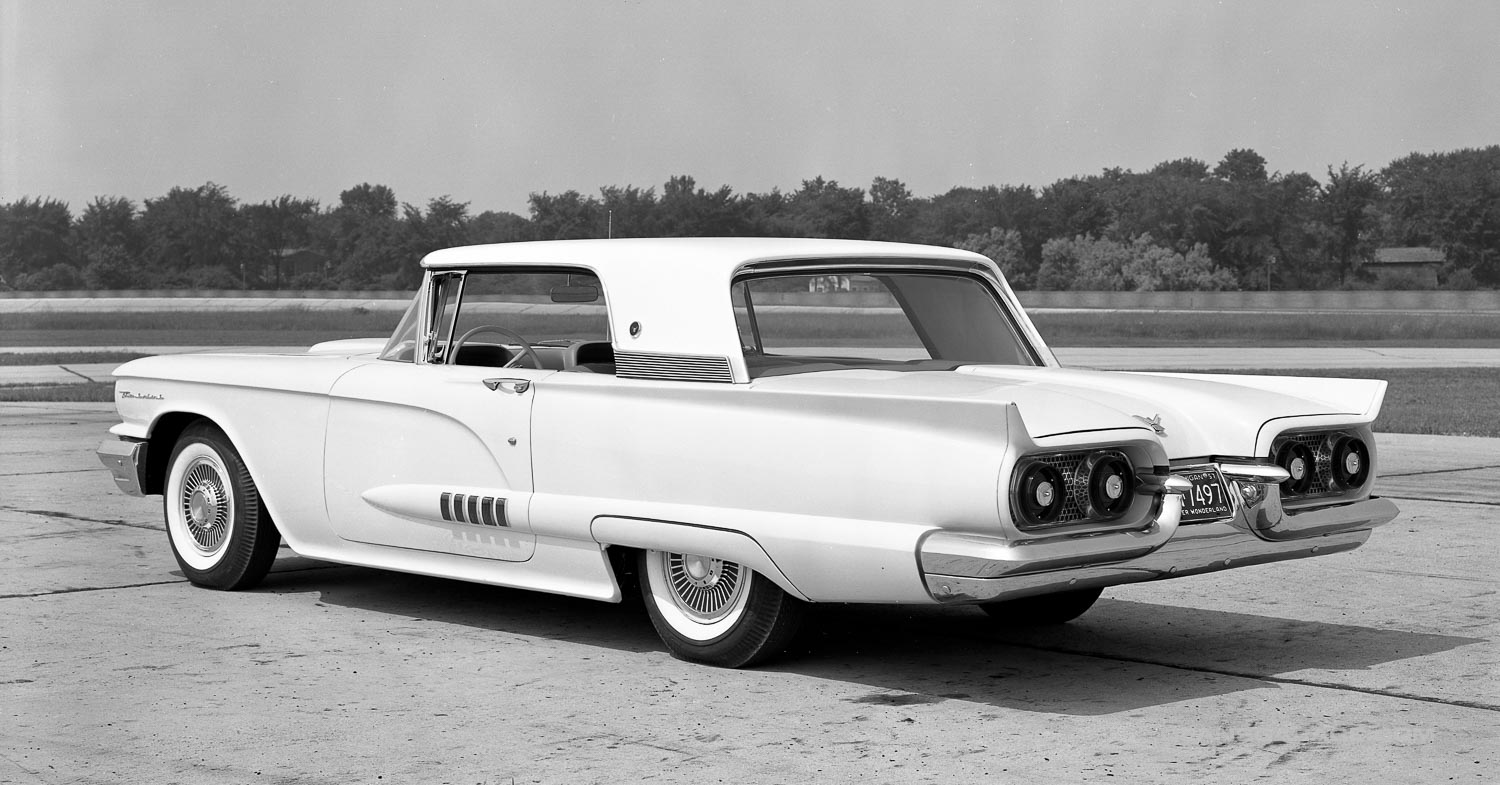
Here we have in this undated photograph a freshly produced ’58 Thunderbird on the test track. Judging by the leaves on the trees I would guess this was taken after May of 1958.
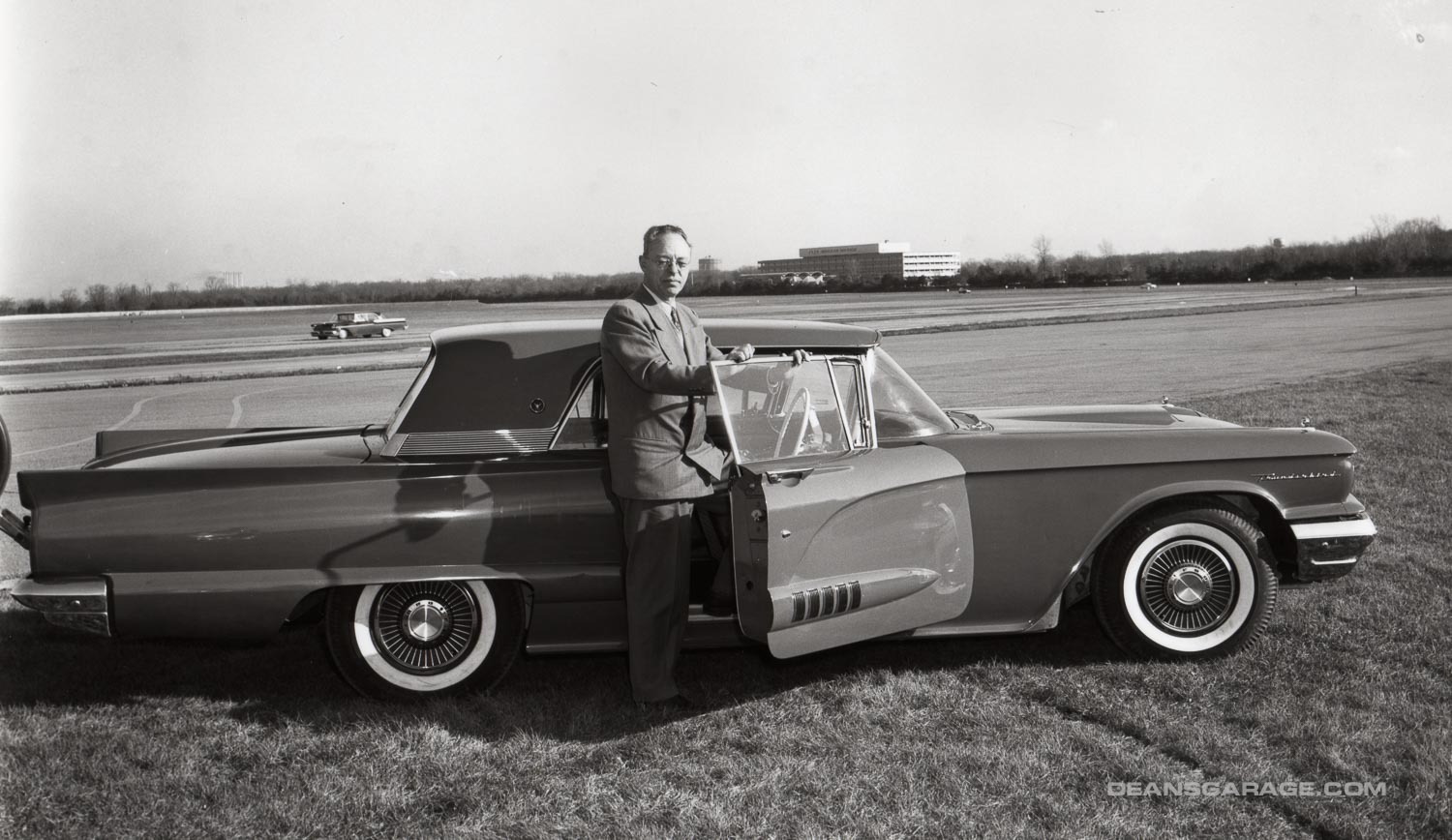
In this picture taken on November 20, 1957, with Mr. Devon Francis, we see what is likely a preproduction ’58 Thunderbird, likely built in the Pilot Plant in Allen Park, Michigan. Interesting as regular production of ’58 Thunderbird didn’t start until a month later, December 20, at Wixom Assembly.
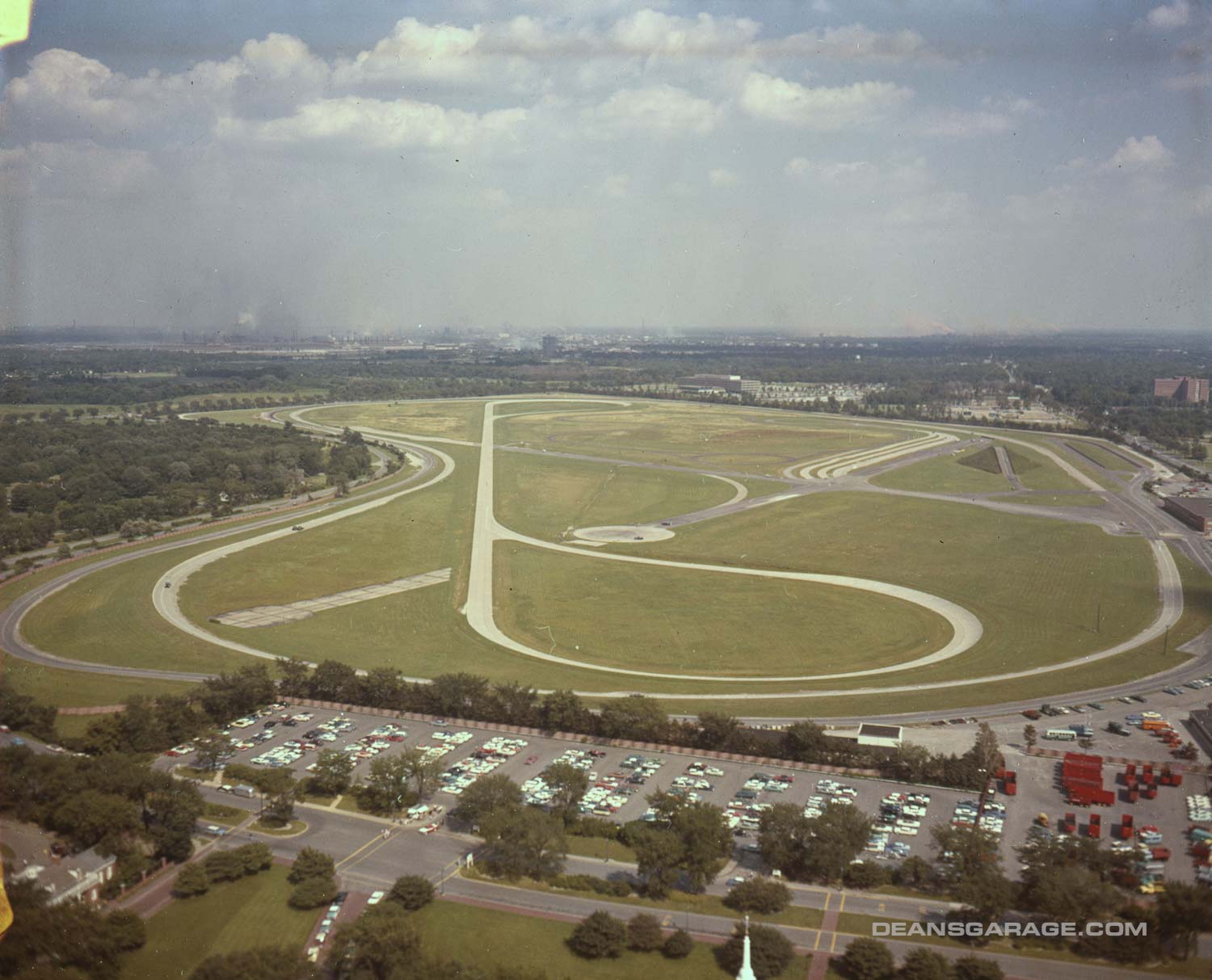
This picture was taken in 1960. The intersection is Oakwood Blvd and Village Road. The Henry Ford Museum on the lower left. The original Stout Aircraft hangars where the Ford Tri-Motors were produced are still in use across Village. Much of the original runways remain but are broken up in places. The River Rouge complex is in the distant background.
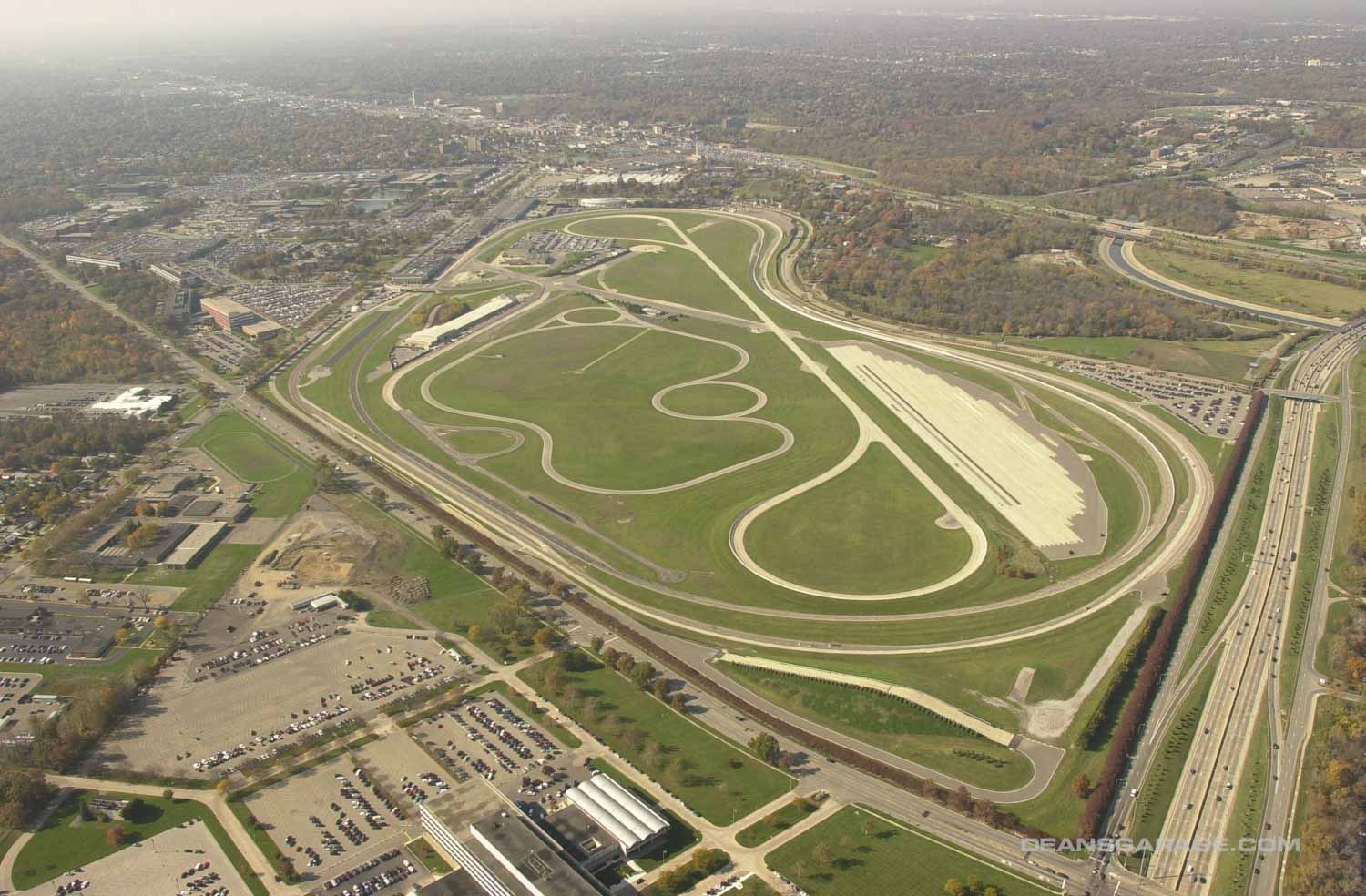
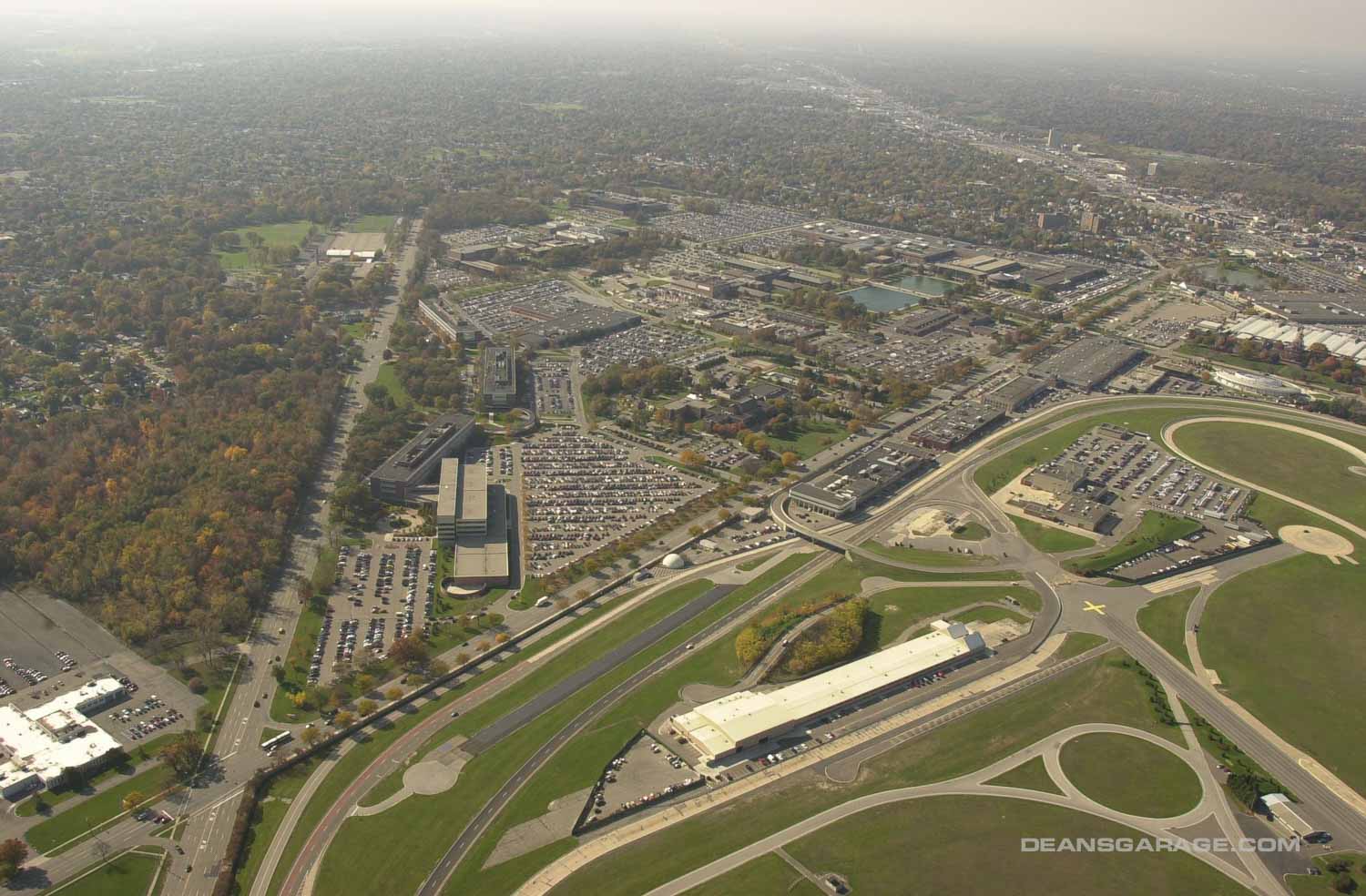
These last two shots from the fall of 2000 show how the test track was constantly being improved. A $65M crash test facility is in the infield. It’s the long building with the white roof. The large area with stripes is actually numerous sections of intentionally rough and challenging roadway including gravel, brick, rutted roads, mud, and cobblestone to name but a few. A wide variety including every surface imaginable on every continent. Just above the intersection of Rotunda and the Southfield Freeway is the new hill climb facility. One can also see the extent of the large Ford Campus in the upper left of the photograph.
The original Stout hangars were eventually replaced with new structures. You can also see the sprawling Ford campus just across Oakwood. Much of this is being transformed again today as mentioned in a previous Dean’s Garage article. Michigan Avenue is the commercial road in the background, and you can see it is fully developed. Note also that even in 2000, portions of the original concrete runways still exist.
In 2006 Ford once again spent another $43M to improve the test track by reconfiguring and repaving most of the original tracks. Both the 2.6 mile high-speed and 2.8 mile rough course outer track were repaved using crushed recycled concrete from the I-94 restoration. With all of these improvements, and the area assuming greater development responsibility, Ford elected to rename the facility the Dearborn Development Center.
As for the airlines, they soon outgrew Detroit City Airport and moved to Willow Run west of Dearborn in ’46 and ’47. There they remained until Wayne County took over Wayne County Airport from the military, built new runways and terminals and the airlines all followed in steps by 1958. It serves today, albeit greatly modernized recently, as Detroit Metro Airport.
I think Henry and Edsel would be very pleased to see that the land they had chosen to advance automotive and aviation technology, reliability and durability was still in great use today and will be for decades to come.

What an amazing collection of pictures… That is a serious look back into history…
Thanks again for these behind the scenes look at the raise of US automotive design and engineering.
Your interesting history text could be improved by a good editor. Besides the misspellings (“hangar” and “aerial”) it could easily be made more smoothly readable. As an editor, I’d be glad to help!
Corrections made. Thanks. Dean’s Garage
A nice historical information.
Amazing photo history and write up. I spent many a Sunday afternoon in the Henry Ford Museum sketching trains, cars etc. for school while in Detroit attending CCS.
Descriptions of landmarks in photos leaves a bit to be desired, and some cars are mis-identified*, but overall, this is an excellent look into an area of Ford history that has rarely, if ever, been covered in such depth! Thank you so very much. I have learned a new chapter. I never knew Detroit’s first airport was so state-of-the-art, or that it eventually became the famous Ford test track center. Fascinating photos, too.
Tom McCahill also described the new ’57 Sunliner as “corners flatter than a mailman’s feet”. I think it was the ’52 De Soto he described “as solid as the Rock of Gibraltar and just as fast.” He was also crazy about ’53 Sunliners.
*The frozen ’57 Ford is a Custom Fordor Sedan. The ’51 is actually a convertible. The ’58 Club Victoria (with the two Thunderbirds) is a Fairlane 500.
Great review. Looking forward to more.
Todd: Your knowledge and interest in Ford products always intrigues me. Good on ya! I guess our kids will have to fight over our ‘14 F350 and ‘12 Mustang GT convertible when I’m gone. Conrad
I grew up in the neighborhood and worked mostly in Bldg. #5.
The Allen Park plant did not become a prototype assembly line until 1959. Prior to that it housed the Continental Division, then the Edsel Division.
Enjoyed this! Great company and a brilliant founder! Way ahead of his time with such innovative ideas. Triple EEE building with icons like Henry, Edison, Firestone, etc. l was fortunate to have been on the assembly line helping to build the first Mustangs in 1964.
Hired in 5/4/77 as NVH technician, retired 3/1/2007.
4th generation Ford salary employee. Spent many hours on that test track and most all other test facilities, cold rooms, wind tunnels, dynamometers ect. I would drive by the old airplane hangers with the large hanger doors on the way to the track and think of the history. Made wonderful friends there. Loved the article/pictures.
My brother sent me this link, thanks Neil !
The pictures are fabulous! Unfortunately they cannot be clicked to enlarge them any further, so it was very difficult to follow the captions and see what was pointed out, particularly for the aerial photos. For example, the 1960 aerial photo mentions the Stout hangars but I see no such structures. But thank you regardless, this is a wonderful collection of photos.
Worked in Building #3 and then the now demolished NAAO building. Lots of time looking at power hop hill on the test track.
Nice article.